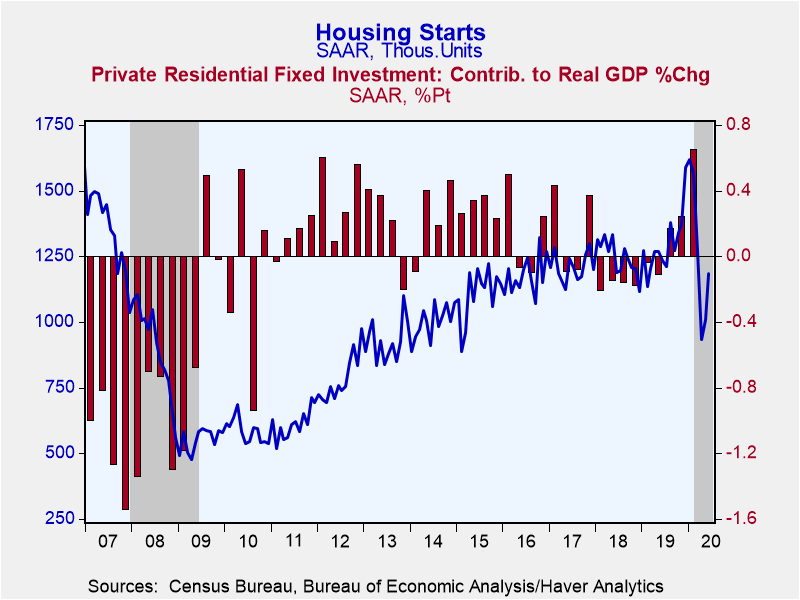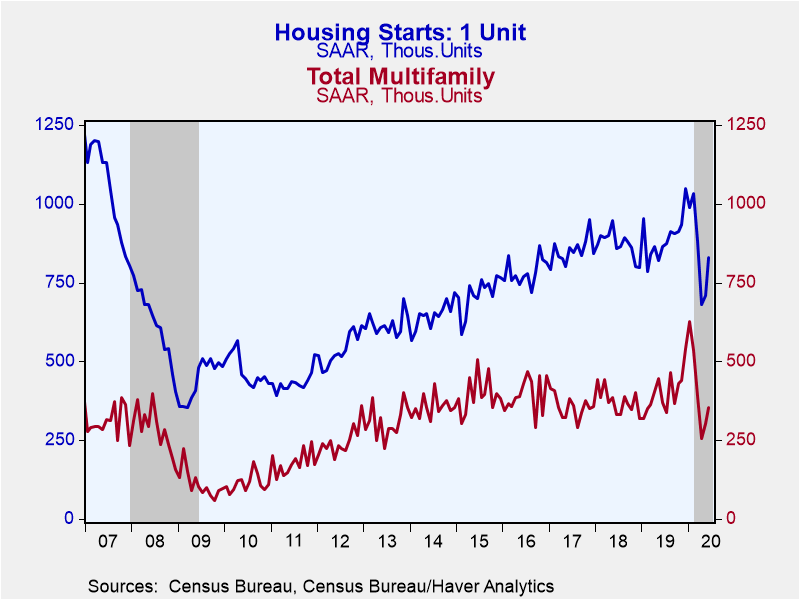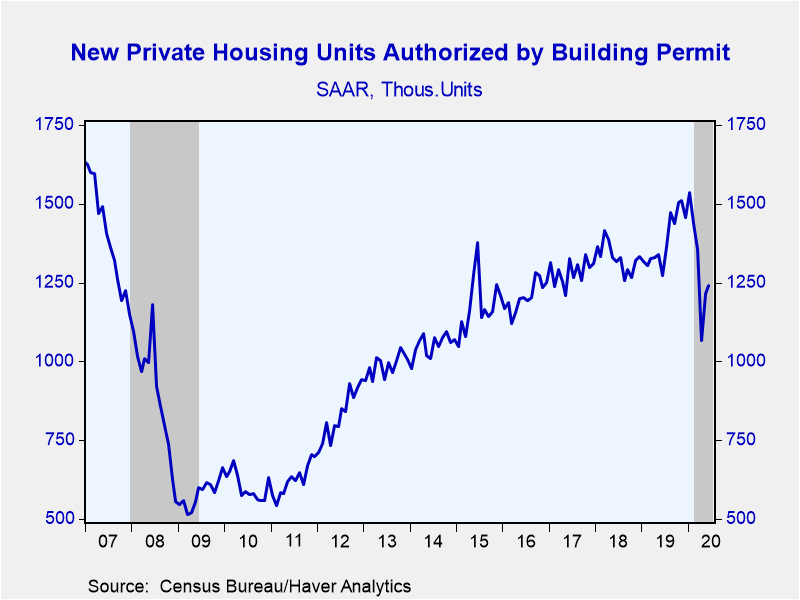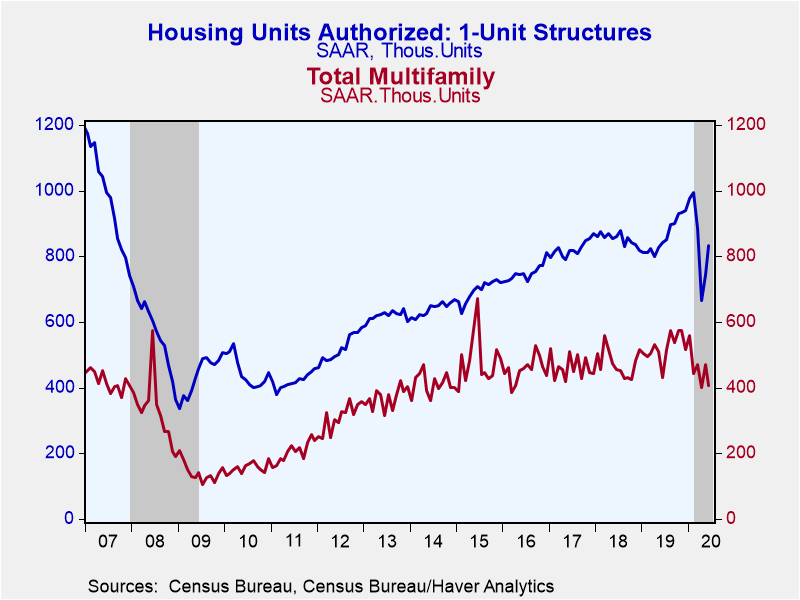 Global| Jul 17 2020
Global| Jul 17 2020U.S. Housing Starts Strengthen in June; Building Permits Rise
by:Tom Moeller
|in:Economy in Brief
Summary
• Home building continues to recover from coronavirus shutdown. • Building permits increase modestly. Low mortgage rates are bolstering new home building activity. Residential housing starts strengthened 17.3% last month (-4.0% y/y) [...]
• Home building continues to recover from coronavirus shutdown.
• Building permits increase modestly.
Low mortgage rates are bolstering new home building activity. Residential housing starts strengthened 17.3% last month (-4.0% y/y) to 1.186 million (SAAR) from 1.011 million in May, revised from 974,000. Despite these gains, total starts remain 26.7% below their January peak. The Action Economics Forecast Survey expected 1.174 million starts in June.
Starts of single-family homes rose 17.2% last month (-3.9% y/y) to 831,000 after the 4.4% May improvement to 709,000, revised from 675,000. Multi-family starts increased 17.5% (-4.1% y/y) to 355,000 from 302,000 in May, revised from 299,000.
A 2.1% increase (-2.5% y/y) in building permits to 1.241 million units followed a little-revised 14.1% May improvement. Permits to build single-family homes increased 11.8% (-1.1% y/y) to 834,000 after improving 12.0% in May. Permits to build multi-family homes fell 13.4% (-5.3% y/y) and reversed most of May's increase.
By region, last month's improvement in housing starts reflected a 114.3% increase (-5.4% y/y) in the Northeast to 105,000. It followed declines in each of the prior four months and starts remained 51.6% below January. In the Midwest, housing starts rose 29.3% (-0.5% y/y) to 181,000 after rising 3.7% in May. In the South, starts increased 20.2% (-4.6% y/y) to 606,000 after three months of sharp decline. Starts in the West fell 7.5% to 294,000 after a 76.7% May strengthening.
The housing starts and permits figures can be found in Haver's USECON database. The expectations figure is contained in the AS1REPNA database.
Rising to the Challenge: Central Banking, Financial Markets, and the Pandemic from John C. Williams, President & CEO, Federal Reserve Bank of New York can be found here.
| Housing Starts (000s, SAAR) | Jun | May | Apr | Jun Y/Y % | 2019 | 2018 | 2017 |
|---|---|---|---|---|---|---|---|
| Total | 1,186 | 1,011 | 934 | -4.0 | 1,295 | 1,248 | 1,207 |
| Single-Family | 831 | 709 | 679 | -3.9 | 893 | 872 | 851 |
| Multi-Family | 355 | 302 | 255 | -4.1 | 403 | 376 | 356 |
| Starts By Region | |||||||
| Northeast | 105 | 49 | 50 | -5.4 | 115 | 111 | 112 |
| Midwest | 181 | 140 | 135 | -0.5 | 170 | 170 | 180 |
| South | 606 | 504 | 569 | -4.6 | 689 | 630 | 602 |
| West | 294 | 318 | 180 | -4.2 | 322 | 337 | 314 |
| Building Permits | 1,241 | 1,216 | 1,066 | -2.5 | 1,386 | 1,329 | 1,285 |
Tom Moeller
AuthorMore in Author Profile »Prior to joining Haver Analytics in 2000, Mr. Moeller worked as the Economist at Chancellor Capital Management from 1985 to 1999. There, he developed comprehensive economic forecasts and interpreted economic data for equity and fixed income portfolio managers. Also at Chancellor, Mr. Moeller worked as an equity analyst and was responsible for researching and rating companies in the economically sensitive automobile and housing industries for investment in Chancellor’s equity portfolio. Prior to joining Chancellor, Mr. Moeller was an Economist at Citibank from 1979 to 1984. He also analyzed pricing behavior in the metals industry for the Council on Wage and Price Stability in Washington, D.C. In 1999, Mr. Moeller received the award for most accurate forecast from the Forecasters' Club of New York. From 1990 to 1992 he was President of the New York Association for Business Economists. Mr. Moeller earned an M.B.A. in Finance from Fordham University, where he graduated in 1987. He holds a Bachelor of Arts in Economics from George Washington University.










